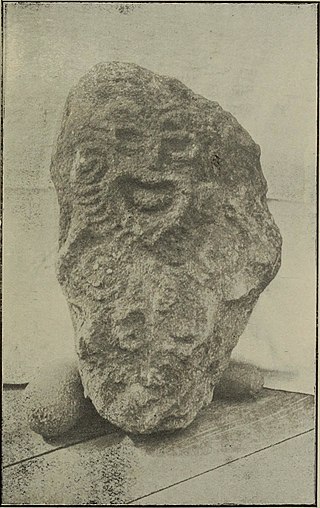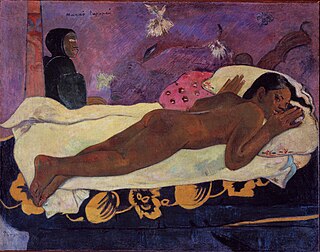Related Research Articles

The Polynesian narrative or Polynesian mythology encompasses the oral traditions of the people of Polynesia together with those of the scattered cultures known as the Polynesian outliers. Polynesians speak languages that descend from a language reconstructed as Proto-Polynesian - probably spoken in the Tonga - Samoa area around 1000 BC.
Māui (Maui) is the great culture hero and trickster in Polynesian mythology. Very rarely was Māui actually worshipped, being less of a deity and more of a folk hero. His origins vary from culture to culture, but many of his main exploits remain relatively similar.

In Māori mythology, Rongo or Rongo-mā-Tāne is a major god (atua) of cultivated plants, especially kumara, a vital crop. Other crops cultivated by Māori in traditional times included taro, yams (uwhi), cordyline (tī), and gourds (hue). Because of their tropical origin, most of these crops were difficult to grow except in the far north of the North Island, hence the importance of Rongo in New Zealand.

In Māori mythology the primal couple Rangi and Papa appear in a creation myth explaining the origin of the world. In some South Island dialects, Rangi is called Raki or Rakinui.
Tangaroa is the great atua of the sea, lakes, rivers, and creatures that live within them, especially fish, in Māori mythology. As Tangaroa-whakamau-tai he exercises control over the tides. He is sometimes depicted as a whale.
In Polynesian languages the word aitu refers to ghosts or spirits, often malevolent. The word is common to many languages of Western and Eastern Polynesia. In the mythology of Tonga, for example, ʻaitu or ʻeitu are lesser gods, many being patrons of specific villages and families. They often take the form of plants or animals, and are often more cruel than other gods. These trouble-making gods are regarded as having come from Samoa. The Tongan word tangi lauʻaitu means to cry from grief, to lament.
Atea is a deity in several Polynesian cultures, including the Marquesas and Tuamotu Islands, and New Zealand.
Miru is a goddess in the Polynesian mythology of the Cook Islands who lives in Avaiki beneath Mangaia. She feeds the souls of dead people a bowl of live centipedes, causing them to writhe in agony, then encourages them to seek relief by diving into a lake, where they drown and can be cooked and eaten at her leisure. The Tapairu are her daughters, and Tau-Titi is her son.
In the mythology of Mangaia, Tau-Titi is a son of Miru.
In the mythology of Mangaia in the Cook Islands, the Tapairu are elves or fairies, who are named after the four daughters of Miru, the deformed goddess of the underworld. They were said to have been present when mortals danced in honor of their brother, Tau-Titi. They were also associated with the god Tane.

In Cook Islands mythology, Avatea was a lunar deity and the father of gods and men in Mangaian myth of origin. His eyes were thought to be the Sun and the Moon; he was also known as the god of light.
Motoro is a god in Polynesian mythology, the tribal god of the Ngariki of Mangaia. He is the son of Tangiia and the brother of Ruanuku, Kereteki and Utakea. While travelling to Mangaia he argued with his two eldest brothers, was thrown into the sea, and devoured by sharks. His spirit then floated to Mangaia on a piece of hibiscus. He was known as i'o ora because his followers could not be used as human sacrifices.
In the mythology of Mangaia in the Cook Islands, Moko is a wily character and grandfather of the heroic Ngaru.
In the mythology of Mangaia in the Cook Islands, Tikokura is a sea-dwelling evil spirit in the shape of a storm wave.
In Polynesian mythology, Tuna is a god of eels. In Hawaiian mythology he fights with Māui, who is having an affair with his wife Hina. Māui kills him, cuts off his head, and plants it near his home. A green shoot emerges from the spot where the head was buried, and grows into the first coconut palm. In the mythology of Mangaia Tuna is the lover of Hine, and asks that his head be cut off and planted in order to stop a flood. A coconut shoot grows from the head. A variant of the story is told in the Samoan myth of Sina and the Eel.

Mangaia is the most southerly of the Cook Islands and the second largest, after Rarotonga. It is a roughly circular island, with an area of 51.8 square kilometres (20.0 sq mi), 203 kilometres (126 mi) from Rarotonga. Originally heavily populated, Mangaia's population has dropped by 75% in the last 50 years.
In Māori oral tradition, Rarohenga refers to the subterranean realm where spirits of the deceased dwell after death. The underworld is ruled by the Goddess of Death and Night, Hine-nui-te-pō. Additional occupants include Guardians, Gods, Goddesses, Holy Chiefs and Nobles (Rangatira), and the tūrehu, who are described as celestial, fairy-like people. Rarohenga is predominantly depicted as a place of peace and light. As articulated by Māori ethnographer, Elsden Best: It is a place where darkness is unknown, as darkness “pertains only to the upper world”. “This is the reason why, of all spirits of the dead, since the time of Hine-ahu-one… not a single one has ever returned, or hither[ed] to dwell in this world”.
Tangaloa was an important family of gods in Tongan mythology. The first Tangaloa was the cousin of Havea Hikuleʻo and Maui, or in some sources the brother or son or father of them. He was Tangaloa ʻEiki, and was assigned by his father, Taufulifonua, the realm of the sky to rule.

There was widespread belief in ghosts in Polynesian culture, some of which persists today. After death, a person's ghost would normally travel to the sky world or the underworld, but some could stay on earth. In many Polynesian legends, ghosts were often involved in the affairs of the living. Ghosts might also cause sickness or even invade the body of ordinary people, to be driven out through strong medicines.

Cook Islands mythology comprises historical myths, legends, and folklore passed down by the ancient Cook Islanders over many generations. Many of the Cook Islands legends were recited through ancient songs and chants. The Cook Islands myths and legends have similarities to general Polynesian mythology, which developed over the centuries into its own unique character.
References
- ↑ William Wyatt Gill (1876). Myths and Songs from the South Pacific. London: H. S. King & Company. p. 225-237.
- ↑ Michael P. J. Reilly (2015). "NGARU: A CULTURE HERO OF MANGAIA" (PDF). Journal of the Polynesian Society. 124 (2): 150-153. Archived (PDF) from the original on 2018-02-12. Retrieved 2 September 2020.
- ↑ R.D. Craig (1989). Dictionary of Polynesian Mythology. New York: Greenwood Press. p. 184.